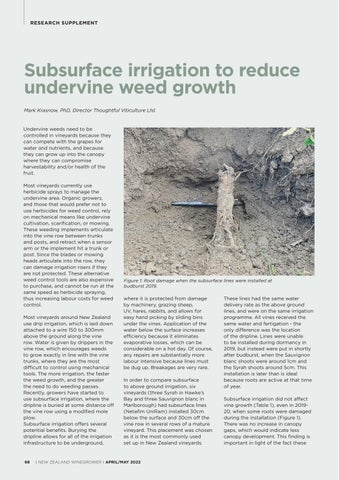RESEARCH SUPPLEMENT
Subsurface irrigation to reduce undervine weed growth Mark Krasnow, PhD, Director Thoughtful Viticulture Ltd.
Undervine weeds need to be controlled in vineyards because they can compete with the grapes for water and nutrients, and because they can grow up into the canopy where they can compromise harvestability and/or health of the fruit. Most vineyards currently use herbicide sprays to manage the undervine area. Organic growers, and those that would prefer not to use herbicides for weed control, rely on mechanical means like undervine cultivation, scarification, or mowing. These weeding implements articulate into the vine row between trunks and posts, and retract when a sensor arm or the implement hit a trunk or post. Since the blades or mowing heads articulate into the row, they can damage irrigation risers if they are not protected. These alternative weed control tools are also expensive to purchase, and cannot be run at the same speed as herbicide spraying, thus increasing labour costs for weed control. Most vineyards around New Zealand use drip irrigation, which is laid down attached to a wire 150 to 300mm above the ground along the vine row. Water is given by drippers in the vine row, which encourages weeds to grow exactly in line with the vine trunks, where they are the most difficult to control using mechanical tools. The more irrigation, the faster the weed growth, and the greater the need to do weeding passes. Recently, growers have started to use subsurface irrigation, where the dripline is buried at some distance off the vine row using a modified mole plow. Subsurface irrigation offers several potential benefits. Burying the dripline allows for all of the irrigation infrastructure to be underground,
68
Figure 1: Root damage when the subsurface lines were installed at budburst 2019.
where it is protected from damage by machinery, grazing sheep, UV, hares, rabbits, and allows for easy hand picking by sliding bins under the vines. Application of the water below the surface increases efficiency because it eliminates evaporative losses, which can be considerable on a hot day. Of course, any repairs are substantially more labour intensive because lines must be dug up. Breakages are very rare. In order to compare subsurface to above ground irrigation, six vineyards (three Syrah in Hawke’s Bay and three Sauvignon blanc in Marlborough) had subsurface lines (Netafim UniRam) installed 30cm below the surface and 30cm off the vine row in several rows of a mature vineyard. This placement was chosen as it is the most commonly used set up in New Zealand vineyards.
I NEW ZEALAND WINEGROWER I APRIL/MAY 2022
These lines had the same water delivery rate as the above ground lines, and were on the same irrigation programme. All vines received the same water and fertigation - the only difference was the location of the dripline. Lines were unable to be installed during dormancy in 2019, but instead were put in shortly after budburst, when the Sauvignon blanc shoots were around 1cm and the Syrah shoots around 5cm. This installation is later than is ideal because roots are active at that time of year. Subsurface irrigation did not affect vine growth (Table 1), even in 201920, when some roots were damaged during the installation (Figure 1). There was no increase in canopy gaps, which would indicate less canopy development. This finding is important in light of the fact these
